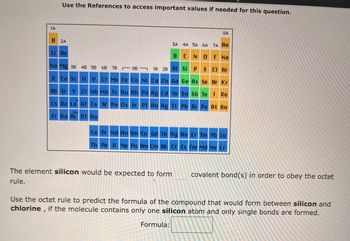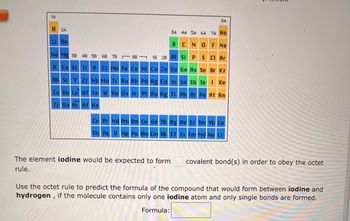
Chemistry
10th Edition
ISBN: 9781305957404
Author: Steven S. Zumdahl, Susan A. Zumdahl, Donald J. DeCoste
Publisher: Cengage Learning
expand_more
expand_more
format_list_bulleted
Concept explainers
Question

Transcribed Image Text:1A
Use the References to access important values if needed for this question.
H 2A
Li Be
3A 4A 5A 6A 7A He
B
CNOF Ne
S Cl Ar
Na Mg 38 48 58 68 78
88
K Ca Sc Ti V Cr Mn Fe Co Ni Cu Zn Ga Ge As Se Br Kr
Rb Sr Y Zr Nb Mo Tc Ru Rh Pd Ag Cd In Sn Sb Te I Xe
Cs Ba La Hf Ta W Re Os Ir Pt Au Hg Tl Pb Bi Po At Rn
Fr Ra Ac Rf Ha
1B 2B Al Si
8A
The element silicon would be expected to form
rule.
P
Ce Pr Nd Pm Sm Eu Gd Tb Dy Ho Er Tm Yb Lu
Th Pa U Np Pu Am Cm Bk Cf Es Fm Md No Lr
covalent bond(s) in order to obey the octet
Use the octet rule to predict the formula of the compound that would form between silicon and
chlorine, if the molecule contains only one silicon atom and only single bonds are formed.
Formula:

Transcribed Image Text:1A
H 2A
Li Be
8A
3A 4A 5A 6A 7A He
BCN
O F Ne
Na Mg 38 4B 5B 6B 7B8B
1B 2B Al Si P
S Cl Ar
K Ca Sc Ti V Cr Mn Fe Co Ni Cu Zn Ga Ge As Se Br Kr
Sn Sb Te I Xe
Rb Sr Y Zr Nb Mo Tc Ru Rh Pd Ag Cd In
Cs Ba La Hf Ta W Re Os Ir Pt Au Hg Tl Pb Bi Po At Rn
Fr Ra Ac Rf Ha
Ce Pr Nd Pm Sm Eu Gd Tb Dy Ho Er Tm Yb Lu
Th Pa U Np Pu Am Cm Bk Cf Es Fm Md No Lr
The element iodine would be expected to form
rule.
covalent bond(s) in order to obey the octet
Use the octet rule to predict the formula of the compound that would form between iodine and
hydrogen, if the molecule contains only one iodine atom and only single bonds are formed.
Formula:
Expert Solution
This question has been solved!
Explore an expertly crafted, step-by-step solution for a thorough understanding of key concepts.
Step by stepSolved in 3 steps

Knowledge Booster
Learn more about
Need a deep-dive on the concept behind this application? Look no further. Learn more about this topic, chemistry and related others by exploring similar questions and additional content below.Similar questions
- The answer to question 3arrow_forward1A BA H 2A 3A 4A 5A 6A 7A He Li Be BCNO F Ne Na Mg 38 4B 5B 6B 7B - 8B - IB 28 AI Si PS CI Ar K Ca sc Ti v Cr Mn Fe Co Ni Cu Zn Ga Ge As se Br Kr Rb Sr Y zr Nb Mo Tc Ru Rh Pd Ag cd In Sn Sb Te I Xe Cs Ba La HT Ta w Re Os Ir Pt Au Hg TI Pb Bi Po At Rn Fr Ra Ac Rf Ha Ce Pr Nd Pm Sm Eu Gd Tb Dy Ho Er Tm Yb Lu Th Pa u Np Pu Am Cm Bk cr Es Fm Md No Lr Using only the periodic table arrange the following elements in order of increasing atomic radius: antimony, iodine, rubidium, xenon Smallest Largestarrow_forward1A H2A Li Be 4A 5A 6A 7A He CNOF Ne Cl Ar Na Mg 3B 48 58 68 7888 Si P S K Ca Sc Ti V Cr Mn Fe Co Ni Cu Zn Ga Ge As Se Br Kr Pd Ag Cd In Sn Sb Te I Xe Rb Sr Y Zr Nb Mo Tc Ru Rh Cs Ba La Hf Ta W Re Os Ir Pt Au Hg Tl Pb Bi Po At Rn Fr Ra Rc Rf Ha C Submit Answer 3A 1B 2B Al 8A Ce Pr Nd Pm Sm Eu Gd Tb Dy Ho Er Tm Yb Lu Th Pa U Np Pu Am Cm Bk Cf Es Fm Md No Lr A monatomic ion with a charge of +2 has an electronic configuration of 1s²2s²2p63s23p64s²3d¹04p6. This ion is a(n) It has the same electron configuration as the noble gas The symbol for the ion is: Retry Entire Group eded for this question. 8 more group attempts remainingarrow_forward
- What’s the answer to 3.arrow_forward1A H 2A Li Be 3A 4A 5A 6A 7A He BCN O F Ne 1B 2B Al Si P S Cl Ar Na Mg 38 4B 5B 6B 7B8B K Ca Sc Ti V Cr Mn Fe Co Ni Cu Zn Ga Rb Sr Y Zr Nb Mo Tc Ru Rh Pd Ag Cd In 8A Ge As Se Br Kr Sn Sb Te I Xe Cs Ba La Hf Ta W Re Os Ir Pt Au Hg Tl Pb Bi Po At Rn **** Fr Ra Ac Rf Ha Ce Pr Nd Pm Sm Eu Gd Tb Dy Ho Er Tm Yb Lu Th Pa U Np Pu Am Cm Bk Cf Es Fm Md No Lr Write the complete electron configuration for the zinc ion. Using NOBLE GAS notation write the electron configuration for the copper(1) ion.arrow_forward1A H2A 8B Li Be Na Mg 3B 4B 5B 6B 7B 1B 2B Al Si P K Ca Sc Ti V Cr Mn Fe Co Ni Cu Zn Ga Ge As Se Br Kr Rb Sr Y Zr Nb Mo Tc Ru Rh 3A 4A 5A 6A 7A He BCN OF Ne S Cl Ar 8A Pd Ag Cd In Cs Ba La Hf Ta W Re Os Ir Pt Au Hg Tl _** Fr Ra Ac Rf Ha Sn Sb Te I Xe Pb Bi Po At Rn Ce Pr Nd Pm Sm Eu Gd Tb Dy Ho Er Tm Yb Lu Th Pa U Np Pu Am Cm Bk Cf Es Fm Md No Lr (1) The element with an electron configuration of 1s²2s²2p63s²3p64s²3d² is in group (2) The element with an electron configuration of 1s²2s² is in group and period and periodarrow_forward
- 1A 8A H 2A 3A 4A 5A 6A 7A He Li Be Na Mg 3B 4B 5B 6B 7B 8B- 1B 2B AI| Si P K Ca Sc Ti VCr Mn Fe Co Ni Cu Zn Ga Ge As Se Br Kr Rb Sr Y Zr Nb Mo Tc Ru Rh Pd Ag Cd In Sn Sb Te IXe Cs Ba La Hf Ta W Re Os Ir Pt Au Hg TI Pb Bi Po At Rn 米 ** Fr Ra Ac Rf Ha Ce Pr Nd Pm Sm Eu Gd Tb Dy Ho Er Tm Yb Lu Th Pa UNp Pu Am Cm Bk Cf Es Fm Md No Lr (1) What is the name of the element with a valence electron configuration of 3s'? (2) What is the name of the element with a valence electron configuration of 4s24p1? Submit Answer Try Another Version 5 item attempts remaining Cengage Learning | Cengage Technical Support search 近 0 20,arrow_forward1A 8A H 2A 3A 4A 5A 6A 7A He Li Be BC NO FNe Na Mg зв 4в 5B 6B 7B - 8B - 1B 28 A1 Si P S CI Ar K Ca Sc Ti v Cr Mn Fe Co Ni Cu Zn Ga Ge As Se Br Kr Rb Sr Y Zr Nb Mo Tc Ru Rh Pd Ag cd In Sn Sb Te I Xe Cs Ba La Hf Ta W Re Os Ir Pt Au Hg TI Pb Bi Po At Rn ** Fr Ra Ac Rf Ha Ce Pr Nd Pm Sm Eu Gd Tb Dy Ho Er Tm Yb Lu Th Pa U Np Pu Am Cm Bk Cf Es Fm Md No Lr (1) The element with an electron configuration of 1s²2s²2p°3s 64s²3d6 is in group 8 and period 4 (2) The element with an electron configuration of 1s²2s²2p°3s' is in group and periodarrow_forward1A 8A H 2A 3A 4A 5A 6A 7A He Li Be BC NO F Ne Na Mg 38 4B 5B 6B 7B -88 - 1B 28 AI si P S CI Ar K Ca sc Ti v Cr Mn Fe Co Ni Cu Zn Ga Ge As Se Br Kr Rb Sr Y Zr Nb Mo Tc Ru Rh Pd Ag Cd In Sn Sb Te I Xe Cs Ba La Hf Ta W Re Os Ir Pt Au Hg TI Pb Bi Po At Rn ** Fr Ra Ac Rf Ha Ce Pr Nd Pm Sm Eu Gd Tb Dy Ho Er Tm Yb Lu Th Pa U Np Pu Am Cm Bk Cf Es Fm Md No Lr (1) What is the element with an electron configuration of 1s²2s²2p°3s²3p°4s²3a$? (2) What is the element with an electron configuration of 1s2s²2p°3s²3p°4s?arrow_forward
- Li Be N. OF Ne Na Mg 3B 4B 5B 6B 7B 8B- 1B 2B A1 Si PS CI Ar K Ca Sc Ti V Cr Mn Fe Co NI Cu Zn Ga Ge As Se Br Kr Rb Sr Y Zr Nb Mo To Ru Rh Pd Ag Cd In Sn Sb Te Xe Cs Ba La H Ta W Re Os Ir Pt Ru Hg TI Pb Bi Po At Rn Fr Ra Ac Rf Ha Ce Pr Nd Pm Sm Eu Gd Tb Dy Ho Er Tm Yb Lu Th Pa U Np Pu Am Cm Bk Cr Es Fm Md No Lr (1) What is the complete ground state electron configuration for the carbon atom? 1s2s22p² (2) What is the complete ground state electron configuration for the iron atom? Submit Answerarrow_forward1A H 2A Li Be OF Ne Na Mg 3B 4B 5B 6B 7888 18 2B Al Si P S Cl Ar K Ca Sc Ti V Cr Mn Fe Co Ni Cu Zn Ga Ge As Se Br Kr Rb Sr Y Zr Nb Mo Tc Ru Rh Pd Ag Cd In Sn Sb Te I Xe 8A 3A 4A 5A 6A 7A He BCN Cs Ba La Hf Ta W Re Os Ir Pt Au Hg Tl Pb Bi Po At Rn *** Fr Ra Ac Rf Ha Ce Pr Nd Pm Sm Eu Gd Tb Dy Ho Er Tm Yb Lu Th Pa U Np Pu Am Cm Bk Cf Es Fm Md No Lr (1) What is the complete ground state electron configuration for the potassium atom? (2) What is the complete ground state electron configuration for the manganese atom?arrow_forward
arrow_back_ios
arrow_forward_ios
Recommended textbooks for you
 ChemistryChemistryISBN:9781305957404Author:Steven S. Zumdahl, Susan A. Zumdahl, Donald J. DeCostePublisher:Cengage Learning
ChemistryChemistryISBN:9781305957404Author:Steven S. Zumdahl, Susan A. Zumdahl, Donald J. DeCostePublisher:Cengage Learning ChemistryChemistryISBN:9781259911156Author:Raymond Chang Dr., Jason Overby ProfessorPublisher:McGraw-Hill Education
ChemistryChemistryISBN:9781259911156Author:Raymond Chang Dr., Jason Overby ProfessorPublisher:McGraw-Hill Education Principles of Instrumental AnalysisChemistryISBN:9781305577213Author:Douglas A. Skoog, F. James Holler, Stanley R. CrouchPublisher:Cengage Learning
Principles of Instrumental AnalysisChemistryISBN:9781305577213Author:Douglas A. Skoog, F. James Holler, Stanley R. CrouchPublisher:Cengage Learning Organic ChemistryChemistryISBN:9780078021558Author:Janice Gorzynski Smith Dr.Publisher:McGraw-Hill Education
Organic ChemistryChemistryISBN:9780078021558Author:Janice Gorzynski Smith Dr.Publisher:McGraw-Hill Education Chemistry: Principles and ReactionsChemistryISBN:9781305079373Author:William L. Masterton, Cecile N. HurleyPublisher:Cengage Learning
Chemistry: Principles and ReactionsChemistryISBN:9781305079373Author:William L. Masterton, Cecile N. HurleyPublisher:Cengage Learning Elementary Principles of Chemical Processes, Bind...ChemistryISBN:9781118431221Author:Richard M. Felder, Ronald W. Rousseau, Lisa G. BullardPublisher:WILEY
Elementary Principles of Chemical Processes, Bind...ChemistryISBN:9781118431221Author:Richard M. Felder, Ronald W. Rousseau, Lisa G. BullardPublisher:WILEY

Chemistry
Chemistry
ISBN:9781305957404
Author:Steven S. Zumdahl, Susan A. Zumdahl, Donald J. DeCoste
Publisher:Cengage Learning

Chemistry
Chemistry
ISBN:9781259911156
Author:Raymond Chang Dr., Jason Overby Professor
Publisher:McGraw-Hill Education

Principles of Instrumental Analysis
Chemistry
ISBN:9781305577213
Author:Douglas A. Skoog, F. James Holler, Stanley R. Crouch
Publisher:Cengage Learning

Organic Chemistry
Chemistry
ISBN:9780078021558
Author:Janice Gorzynski Smith Dr.
Publisher:McGraw-Hill Education

Chemistry: Principles and Reactions
Chemistry
ISBN:9781305079373
Author:William L. Masterton, Cecile N. Hurley
Publisher:Cengage Learning

Elementary Principles of Chemical Processes, Bind...
Chemistry
ISBN:9781118431221
Author:Richard M. Felder, Ronald W. Rousseau, Lisa G. Bullard
Publisher:WILEY